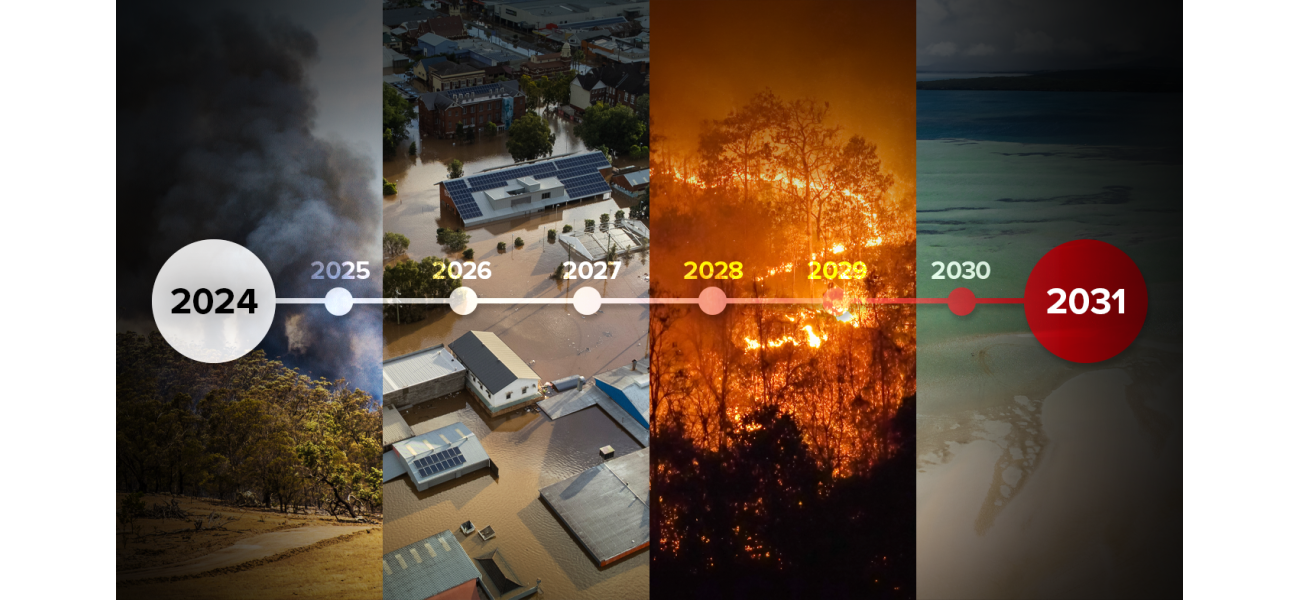Top Aussie scientists set strict deadline for humanity, delivering a wake-up call.
Can we still achieve the goal of limiting global warming to 1.5C as the clock ticks down?
October 31st 2024.

For a long time now, scientists have been sounding the alarm that we are quickly approaching the limit of the Earth's carbon emissions budget. And now, we have been given an ultimatum - a strict deadline that we must meet if we hope to have any chance of limiting global warming to the goals set by the Paris Agreement. At the current rate of greenhouse gas emissions, we have just seven years until we reach the point of no return.
Unfortunately, Australia has already reached this point. Land temperatures have risen by an average of 1.51 degrees since records began in 1910. This is just one of the alarming findings presented in the State of the Climate 2024 report, a joint effort by the CSIRO and the Bureau of Meteorology. The report highlights the extreme weather events that have occurred throughout the world in the past year, including devastating droughts, wildfires, and heatwaves.
The report also sheds light on how Australia's weather patterns have been affected by the changing climate. From shifting rainfall patterns to more frequent and intense heatwaves and bushfires, the impact is clear. And the future looks even more dire. In just 15 years, we will have reached another critical deadline - the chance to limit warming to 1.7 degrees. The message to world leaders is clear - we must take immediate action to reach net zero emissions as soon as possible.
But as Dr. Karl Braganza, the BoM's National Manager of Climate Services, points out, this will not be an easy feat. It's like asking someone with a drinking or smoking habit to quit immediately - it's a challenging task that requires significant changes to our economic, social, and engineering systems. However, Australia is making progress, with emissions declining by 28.2% since 2005. But on a global scale, emissions are just now starting to level off after a century of rapid increases.
In 2023 alone, a staggering 40.9 billion tonnes of carbon dioxide were released into the atmosphere, pushing greenhouse gas levels to an all-time high of 524 parts per million - over 50% higher than pre-industrial times. This level has not been seen on Earth in over three million years. And unfortunately, once these gases are released, their effects last for centuries and are extremely difficult to reverse.
So what does the future hold? The report indicates that the changes we have already witnessed are largely irreversible, and the next few decades of warming are already "locked in." But that does not mean we should give up. Every bit of effort we put into mitigating greenhouse gas emissions will make a difference, even if it's not immediately apparent.
The rate of future warming will be crucial in determining the severity of the impacts we will face. Dr. Jaclyn Brown, the CSIRO's climate research manager, shares that Pacific leaders have already approached them, asking when they will have to leave their homes due to rising sea levels. The urgency and severity of the situation are clear.
Across Australia, we are already feeling the effects of a warming planet. Heatwaves are becoming more frequent and intense, bushfire seasons are now a yearly occurrence, and coastlines are eroding. And these trends are expected to worsen in the coming years. The sooner we can reach net zero emissions, the better chance we have of mitigating these impacts. It's a race against time, but we must do everything we can to protect our planet for future generations.
The scientific community has been warning us for years that the Earth's carbon emissions are pushing us towards a dangerous threshold. And now, we've been given a harsh deadline to act. According to recent projections, we only have seven years left to limit global warming to the goal set by the Paris Agreement - 1.5 degrees Celsius. This may seem like a long time, but Australia is already experiencing an average temperature increase of 1.51 degrees compared to when record-keeping began in 1910.
But the urgency doesn't stop there. In just 15 years, we will reach another critical point - the chance to limit warming to 1.7 degrees. These dire predictions were laid out in the State of the Climate 2024 report, a joint effort by the CSIRO and the Bureau of Meteorology. The report paints a sobering picture of how our changing climate is already affecting Australia, from extreme heatwaves and bushfires to shifts in rainfall patterns. And it's not just our present that is at stake - it's our future and that of our children's.
So, is it still possible to meet the 1.5-degree target? While the absolute deadline may seem far off, the reality is that it will be incredibly challenging to keep temperatures below this threshold. According to Dr Karl Braganza, the National Manager of Climate Services at the BoM, it's widely recognized that this will be no easy feat. The message to world leaders is clear - we must reach net-zero emissions as quickly as possible. But as Dr Braganza points out, this is easier said than done. It's like asking someone with a heavy drinking or smoking habit to quit - it's a challenging process that requires significant changes to economic, social, and engineering systems.
Australia is currently one of 26 countries where emissions are declining, with our latest National Greenhouse Gas Inventory estimating a decrease of 28.2% from 2005 levels. However, globally, emissions have only just started to level off after a century of rapid increases. In 2023 alone, 40.9 billion tonnes of carbon dioxide were released into the atmosphere, bringing the concentration of greenhouse gases to a record high of 524 parts per million, over 50% higher than pre-industrial levels. To put this in perspective, we would have to go back three million years to see greenhouse gases at this level.
And the consequences of these emissions are far-reaching, with their impacts lasting for centuries and being extremely difficult to reverse. This highlights the urgent need for carbon dioxide removal systems, but so far, these have proved challenging to produce at scale. So what does the future hold? The changes that have already occurred on our planet are mostly irreversible, and the next few decades of warming are already "locked in," as the gases we have already emitted continue to heat the oceans.
But as Dr Braganza reminds us, it's not a matter of giving up once we reach 1.5 degrees. While the situation may seem alarming, there is still time to prevent temperatures from rising above two degrees. Every effort we make to reduce the accumulation of greenhouse gases in the atmosphere will have a significant impact later this century. The rate of future warming will also play a crucial role in determining the severity of the consequences. In fact, Pacific leaders have already started asking when they will have to evacuate their islands due to rising sea levels, highlighting the urgency of the situation.
Here in Australia, we are already experiencing the effects of climate change, with more frequent and extreme heatwaves, annual bushfire seasons, coastal erosion, and shifts in rainfall patterns. And unfortunately, these trends are expected to intensify in the coming decades. How much they intensify depends on how quickly we can reach net-zero emissions. It's a race against time, and the consequences of inaction are becoming increasingly dire. The future of our planet and our children's future are at stake, and it's up to all of us to take action now.
Unfortunately, Australia has already reached this point. Land temperatures have risen by an average of 1.51 degrees since records began in 1910. This is just one of the alarming findings presented in the State of the Climate 2024 report, a joint effort by the CSIRO and the Bureau of Meteorology. The report highlights the extreme weather events that have occurred throughout the world in the past year, including devastating droughts, wildfires, and heatwaves.
The report also sheds light on how Australia's weather patterns have been affected by the changing climate. From shifting rainfall patterns to more frequent and intense heatwaves and bushfires, the impact is clear. And the future looks even more dire. In just 15 years, we will have reached another critical deadline - the chance to limit warming to 1.7 degrees. The message to world leaders is clear - we must take immediate action to reach net zero emissions as soon as possible.
But as Dr. Karl Braganza, the BoM's National Manager of Climate Services, points out, this will not be an easy feat. It's like asking someone with a drinking or smoking habit to quit immediately - it's a challenging task that requires significant changes to our economic, social, and engineering systems. However, Australia is making progress, with emissions declining by 28.2% since 2005. But on a global scale, emissions are just now starting to level off after a century of rapid increases.
In 2023 alone, a staggering 40.9 billion tonnes of carbon dioxide were released into the atmosphere, pushing greenhouse gas levels to an all-time high of 524 parts per million - over 50% higher than pre-industrial times. This level has not been seen on Earth in over three million years. And unfortunately, once these gases are released, their effects last for centuries and are extremely difficult to reverse.
So what does the future hold? The report indicates that the changes we have already witnessed are largely irreversible, and the next few decades of warming are already "locked in." But that does not mean we should give up. Every bit of effort we put into mitigating greenhouse gas emissions will make a difference, even if it's not immediately apparent.
The rate of future warming will be crucial in determining the severity of the impacts we will face. Dr. Jaclyn Brown, the CSIRO's climate research manager, shares that Pacific leaders have already approached them, asking when they will have to leave their homes due to rising sea levels. The urgency and severity of the situation are clear.
Across Australia, we are already feeling the effects of a warming planet. Heatwaves are becoming more frequent and intense, bushfire seasons are now a yearly occurrence, and coastlines are eroding. And these trends are expected to worsen in the coming years. The sooner we can reach net zero emissions, the better chance we have of mitigating these impacts. It's a race against time, but we must do everything we can to protect our planet for future generations.
The scientific community has been warning us for years that the Earth's carbon emissions are pushing us towards a dangerous threshold. And now, we've been given a harsh deadline to act. According to recent projections, we only have seven years left to limit global warming to the goal set by the Paris Agreement - 1.5 degrees Celsius. This may seem like a long time, but Australia is already experiencing an average temperature increase of 1.51 degrees compared to when record-keeping began in 1910.
But the urgency doesn't stop there. In just 15 years, we will reach another critical point - the chance to limit warming to 1.7 degrees. These dire predictions were laid out in the State of the Climate 2024 report, a joint effort by the CSIRO and the Bureau of Meteorology. The report paints a sobering picture of how our changing climate is already affecting Australia, from extreme heatwaves and bushfires to shifts in rainfall patterns. And it's not just our present that is at stake - it's our future and that of our children's.
So, is it still possible to meet the 1.5-degree target? While the absolute deadline may seem far off, the reality is that it will be incredibly challenging to keep temperatures below this threshold. According to Dr Karl Braganza, the National Manager of Climate Services at the BoM, it's widely recognized that this will be no easy feat. The message to world leaders is clear - we must reach net-zero emissions as quickly as possible. But as Dr Braganza points out, this is easier said than done. It's like asking someone with a heavy drinking or smoking habit to quit - it's a challenging process that requires significant changes to economic, social, and engineering systems.
Australia is currently one of 26 countries where emissions are declining, with our latest National Greenhouse Gas Inventory estimating a decrease of 28.2% from 2005 levels. However, globally, emissions have only just started to level off after a century of rapid increases. In 2023 alone, 40.9 billion tonnes of carbon dioxide were released into the atmosphere, bringing the concentration of greenhouse gases to a record high of 524 parts per million, over 50% higher than pre-industrial levels. To put this in perspective, we would have to go back three million years to see greenhouse gases at this level.
And the consequences of these emissions are far-reaching, with their impacts lasting for centuries and being extremely difficult to reverse. This highlights the urgent need for carbon dioxide removal systems, but so far, these have proved challenging to produce at scale. So what does the future hold? The changes that have already occurred on our planet are mostly irreversible, and the next few decades of warming are already "locked in," as the gases we have already emitted continue to heat the oceans.
But as Dr Braganza reminds us, it's not a matter of giving up once we reach 1.5 degrees. While the situation may seem alarming, there is still time to prevent temperatures from rising above two degrees. Every effort we make to reduce the accumulation of greenhouse gases in the atmosphere will have a significant impact later this century. The rate of future warming will also play a crucial role in determining the severity of the consequences. In fact, Pacific leaders have already started asking when they will have to evacuate their islands due to rising sea levels, highlighting the urgency of the situation.
Here in Australia, we are already experiencing the effects of climate change, with more frequent and extreme heatwaves, annual bushfire seasons, coastal erosion, and shifts in rainfall patterns. And unfortunately, these trends are expected to intensify in the coming decades. How much they intensify depends on how quickly we can reach net-zero emissions. It's a race against time, and the consequences of inaction are becoming increasingly dire. The future of our planet and our children's future are at stake, and it's up to all of us to take action now.
[This article has been trending online recently and has been generated with AI. Your feed is customized.]
[Generative AI is experimental.]
0
0
Submit Comment





